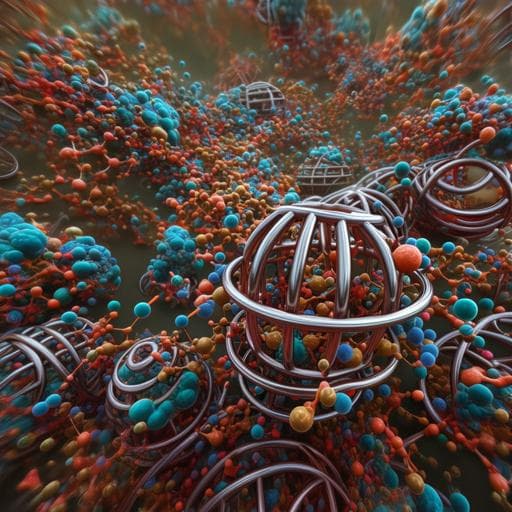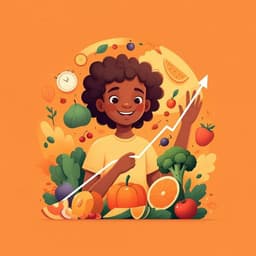
Chemistry
Self-assembly of an anion receptor with metal-dependent kinase inhibition and potent *in vitro* anti-cancer properties
S. J. Allison, J. Bryk, et al.
Discover the groundbreaking research conducted by Simon J. Allison and colleagues, showcasing trimetallic cryptands that not only encapsulate anions but also reveal significant metal-dependent variances in toxicity towards cancer cells, exhibiting remarkable selectivity. Anion modulation appears to control these effects, delving into complex biochemical mechanisms that could pave the way for innovative cancer therapies.
~3 min • Beginner • English
Introduction
The study addresses whether self-assembling, anion-binding metallosupramolecular cryptands can act as selective anti-cancer agents through metal-dependent interactions with phosphate-containing species and modulation of kinase activity. Anions are crucial in cellular signaling and cancer development, yet anion receptors have been little explored as therapeutics. The authors design trimetallic cryptands of the form [L2M3]6+ (M = Cu2+, Zn2+, Mn2+) that encapsulate oxoanions and display metal-dependent reactivity: Cu2+ assemblies bind phosphate esters without hydrolysis, whereas Zn2+ and Mn2+ assemblies hydrolyze phosphate esters. The purpose is to determine how metal identity and pre-encapsulated anions influence chemical reactivity, kinase inhibition, and cancer cell selectivity, providing a tunable supramolecular platform for drug discovery.
Literature Review
The paper situates the work within supramolecular and metallosupramolecular chemistry, referencing foundational concepts of anion binding, self-assembly, metallacycles/metallacages, and anion-templated synthesis. Prior biomedical applications of metallosupramolecular assemblies and anticancer metal complexes are cited, including metallohelices and palladium cages. Reviews on anion receptors and transport, and prior work on anion encapsulation and phosphate sequestration by related systems, are referenced. The oncology context highlights kinases as major drug targets and the prevalence of ATP-competitive inhibitors, motivating alternative mechanisms such as anion-binding driven modulation of phosphorylation.
Methodology
- Synthesis and complex formation: Ligand L prepared by a modification of literature procedures. Complexes formed by reacting L with metal salts (Cu2+, Zn2+, Mn2+ perchlorate or tetrafluoroborate) in MeCN/acetone with H2O. Anion host species prepared by adding Na2O3POPh, Bu4NHPO4, or Bu4NHSO4 to complex solutions. For cytotoxicity, metal acetates were used to form complexes. Perchlorate safety noted. Complexes isolated in small amounts (5–10 mg) and characterized by ESI-MS, NMR, and elemental analysis.
- Spectroscopy and analysis:
- NMR: 1H/13C/DEPT on 300–600 MHz spectrometers. 31P NMR in DMSO-d6/HEPES buffer (60 mM, pH 7.4) or D2O/CD3CN mixtures; temperature and time courses (e.g., 37 °C up to 44 h, 80 °C heating as specified).
- Mass spectrometry: Agilent 6210 TOF (ESI+, ligands) and Bruker Micro TOF-q LC (ESI+, metal complexes). ESI-MS used to track complex formation and anion binding/hydrolysis, including m/z assignments for Cu, Zn, Mn systems.
- UV-Vis: Cary 60 spectrophotometer, 800–250 nm, hourly scans during 37 °C incubation. Hydrolysis of 4-nitrophenyl phosphate monitored at 400 nm. Solutions prepared with defined amounts of ligand, metal (1.5 eq), and substrate (in HEPES pH 7.4); optional addition of Bu4NH2PO4.
- Crystallography: Single crystals from slow evaporation (MeCN/H2O; acetone/MeCN for [L2Zn](ClO4)2). Data at 150 K on Bruker D8 Venture (Mo Kα). Structure solution/refinement with SHELXS-97/SHELXL-2014; Olex2 in some cases; absorption correction via SADABS. Disorder modeled as appropriate.
- Cell culture and chemosensitivity: Human cancer lines (HT29, DLD-1, HCT116 p53+/+ and p53-/-, PSN1, MiaPaCa2, BxPC3, A549, H460, GBM1) and non-cancer models (ARPE-19, MCF10A, NP1) cultured per standard media (RPMI-1640, DMEM, DMEM/F12, MEM Eagle, Neurobasal with supplements). Cells seeded in 96-well plates and exposed continuously for 96 h to test complexes formed freshly in media (final DMSO 0.2%). MTT assay used to derive IC50 values. Selectivity index (SI) defined as IC50(non-cancer)/IC50(cancer).
- Kinase profiling: [L2Cu3]6+ and [L2Zn3]6+ tested at 10 µM in duplicate against 140 purified human kinases (cell-free assay with 33P-ATP) at MRC PPU (University of Dundee). Kinome mapping performed using KinMap; results annotated.
- ATP/substrate competition assays: AMPKα1β2γ1 inhibition by 10 µM complex measured across ATP concentrations (0.5–500 µM). Substrate competition with ADP-Glo assay using SAMStide (1–15 mg/mL). AMP effects assessed (0–160 µM AMP).
- In vitro phosphatase assay: 800 ng recombinant human AMPK (α1β2γ1 or α2β1γ1) or Src incubated with 50 µM complex in 50 mM Tris-HCl pH 7.5 with 50 µM ATP for 4 h at 37 °C; variations included AMP or no nucleotide. Phospho-specific immunoblotting for AMPK Thr172, AMPKβ Ser108, Src Tyr527 and Tyr416.
- Cellular uptake: TSQ Zn-binding dye used after 1 h exposure to 25 µM [L2Zn3]6+ to visualize intracellular zinc-associated signal in ARPE-19 and HCT116 cells by confocal microscopy.
- Autophagy imaging: CYTO-ID staining after 40 h treatment with 3.125 µM complexes; confocal microscopy.
- Metabolic flux: Seahorse XFp Cell Energy Phenotype Assay measuring OCR and ECAR after 1 h or 20 h treatment with 25 µM [L2Zn3]6+; metabolic stress with oligomycin (1 µM) and FCCP (0.25–1 µM) to assess reserve capacity.
- Cellular ATP quantification: CellTiter-Glo after 20 h exposure to serial dilutions (3.125–100 µM) of complexes; normalization to vehicle.
- Immunoblotting: Standard SDS-PAGE and Western blotting with antibodies against total and phospho-AMPKα (T172), AMPKβ1 (S108), Src (total, pY527, pY416), pan-pTyr, p53, LDH-A (total, pY10), β-actin; densitometry by ImageJ.
Key Findings
- Self-assembly and anion encapsulation/hydrolysis:
- Cu2+ with L forms trimetallic [L2Cu3]6+ that encapsulates oxoanions including PhOPO32− without hydrolysis; X-ray confirms [L2Cu3(PhOPO3)]4+ with anion coordinated to three Cu2+ plus NH···anion interactions.
- Zn2+ or Mn2+ with L initially give mono-nuclear [LM]2+ unless templated by SO42− or PO43− to form [L2M3(SO4)]4+ or [L2M3(PO4)]3+; with PhOPO32− they form [L2M3(PhOPO3)]4+ initially but hydrolyze the anion to PO43− upon heating or over time, yielding [L2M3(PO4)]3+ (confirmed by ESI-MS and 31P NMR).
- 31P NMR for Zn2+ system: PhOPO32− at −1.5 ppm (t = 0); after 19 h at 37 °C, dominant signal at 8.6 ppm (identical to [L2Zn3(PO4)]3+); after 44 h, PhOPO32− largely absent. 4-nitrophenyl phosphate is hydrolyzed almost immediately by [L2Zn3]6+ (only [L2Zn3(PO4)]3+ observed, solution turns yellow due to 4-nitrophenolate).
- Substrate scope with [L2Zn3]6+: dephosphorylates phospho-serine and phospho-tyrosine over 24–48 h; phospho-threonine hydrolyzed much more slowly, attributed to steric hindrance from threonine’s methyl group.
- Relative phosphatase rates: Mn2+ complex hydrolyzes 4-nitrophenyl phosphate ~3× faster than Zn2+; Cu2+ complex binds but does not hydrolyze phenyl phosphate.
- Cytotoxicity and selectivity:
- [L2Zn3]6+ IC50 toward cancer cells ranged from 70 ± 13 nM (HCT116 p53−/−) to 59.07 ± 5.60 µM (MiaPaCa2). Most cancer cell IC50 values for both [L2Zn3]6+ and [L2Cu3]6+ were sub-µM, with exceptions (PSN1 and GBM1 >1 µM; MiaPaCa2 >10 µM resistant).
- Selectivity indices (non-cancer/cancer) were generally >10 for both complexes; [L2Zn3]6+ achieved SIs >2000 for HCT116 p53−/− versus ARPE-19 and MCF10A. [L2Cu3]6+ often had SI >100. NP1 cells were more sensitive to Zn2+ complex than to Cu2+.
- [L2Mn3]6+ was potent but with modest selectivity (~2-fold), similar to platinates.
- Formation of trinuclear species is important for selectivity; mono-nuclear [LM]2+ and free ligand lacked selectivity in vitro.
- Pre-encapsulated anions modulate potency/selectivity in a cell line-dependent manner. For PSN1, [L2Zn3(SO4)]4+ and [L2Zn3(O3POPh)]4+ were more potent than [L2Zn3(PO4)]3+ or [L2Zn3]6+, improving selectivity relative to ARPE-19. Some lines (HT-29, DLD-1, BxPC3, A549) showed reduced activity upon anion inclusion. Pre-encapsulated PO43− gave similar potencies to [L2Zn3]6+ alone in most lines; culture media phosphate likely forms [L2Zn3(PO4)]3+ in situ.
- Kinase modulation:
- In a 140-kinase screen at 10 µM, both complexes inhibited multiple kinases, some nearly 100% inhibition. [L2Cu3]6+ inhibited more kinases overall than [L2Zn3]6+; some kinases were selectively affected by one complex. A subset of kinases was activated, notably Src by [L2Zn3]6+.
- AMPK assays showed inhibition by both complexes is non-competitive with ATP and substrate, suggesting allosteric mechanisms.
- Alternative explanations (ATP hydrolysis by complexes, peptide dephosphorylation in assay) were not supported: little/no ATP hydrolysis detected; phosphorylated AMPK peptide was not dephosphorylated by either complex.
- Immunoblotting of recombinant kinases: Both complexes reduced AMPKα Thr172 phosphorylation; [L2Cu3]6+ produced high molecular weight bands with T172P antibody consistent with binding to phospho-sites; [L2Zn3]6+ decreased AMPKβ Ser108P as well. For Src, [L2Zn3]6+ decreased inhibitory Y527P by ~30% and increased activating Y416P ~5-fold, consistent with activation seen in the screen. [L2Cu3]6+ induced high molecular weight bands with total Src antibody, suggesting binding.
- Cellular uptake and downstream effects:
- TSQ staining indicated [L2Zn3]6+ enters both ARPE-19 and HCT116 cells, suggesting uptake is not the driver of selectivity.
- Short exposure (4 h, 10 µM) decreased cellular AMPKα T172P in HCT116 with [L2Zn3]6+, consistent with phosphatase activity; no such decrease reported in ARPE-19 under the same conditions.
- Autophagy: [L2Zn3]6+ and [L2Mn3]6+ induced autophagic vacuoles (CYTO-ID positive) after 40 h; [L2Cu3]6+ did not.
- ATP depletion: [L2Zn3]6+ caused dose-dependent ATP reduction over 20 h, more pronounced in HCT116 than ARPE-19, correlating with selectivity. Mn2+ complex also reduced ATP with less differential effect.
- Metabolic flux: 1 h of 25 µM [L2Zn3]6+ modestly decreased glycolysis in HCT116; 20 h substantially impaired mitochondrial respiration and glycolysis in HCT116 but not ARPE-19.
- Stress signaling: After 40 h at 5 µM, [L2Zn3]6+ increased cellular AMPKα T172P in HCT116 (consistent with low ATP activation), while [L2Cu3]6+ did not. Both complexes increased p53 in HCT116 (~1.7-fold Cu, ~2.7-fold Zn), while p53 decreased in ARPE-19. Pan-phosphotyrosine levels showed a small overall decrease (~10%) with some proteins increased in HCT116 after [L2Zn3]6+.
Discussion
The results demonstrate that anion-binding self-assembled cryptands exert potent and selective anti-cancer effects that depend on the metal ion and the encapsulated anion. Cu2+-based cryptands bind phosphate esters without hydrolysis and likely inhibit kinases by binding to phosphorylated regulatory sites, potentially affecting protein interactions and conformations. Zn2+- and Mn2+-based cryptands act as phosphatases toward phosphate esters, including phosphorylated amino acids, enabling dephosphorylation of regulatory phospho-sites on kinases such as AMPK and Src. This leads to either inhibition or activation depending on the site and kinase, explaining the mixed inhibitory and stimulatory outcomes across the kinome. Non-competitive inhibition of AMPK indicates allosteric modulation rather than ATP or substrate competition. In cells, Zn2+ and Mn2+ complexes induce autophagy and deplete ATP, particularly in cancer cells, consistent with futile cycles of phosphorylation and dephosphorylation and possible direct impairment of glycolysis and mitochondrial respiration. The strong cancer selectivity, especially for [L2Zn3]6+, may reflect greater dependence of cancer cells on dysregulated kinase signaling and metabolic vulnerabilities. Pre-encapsulation of specific anions tunes activity and selectivity in a cell line-dependent manner, indicating the platform’s modularity for targeting different cancer contexts.
Conclusion
Three self-assembled metal-containing anion-binding cryptands were characterized, revealing metal-dependent chemistry and biology. Zn2+ and Mn2+ complexes display significant phosphatase activity with different hydrolysis rates (Mn2+ >> Zn2+), while the Cu2+ complex binds but does not hydrolyze phosphate esters. Both [L2Zn3]6+ and [L2Cu3]6+ show potent, selective anti-cancer activity in vitro, surpassing platinates in selectivity, and modulate multiple kinases through distinct mechanisms (dephosphorylation by Zn2+, binding by Cu2+). Incorporation of different anions at self-assembly provides a straightforward means to modulate potency and selectivity across cancer cell lines, underscoring a flexible, modular drug discovery platform. Future work will employ unbiased phospho-proteomics to identify protein phospho-sites selectively dephosphorylated by [L2Zn3]6+, including potential activity toward phospho-serine/threonine-proline motifs, and to further define the mechanisms underlying kinase modulation and cancer selectivity.
Limitations
- Mechanistic basis of differential effects of pre-encapsulated anions on potency/selectivity remains to be elucidated.
- Potential alternative mechanisms of kinase modulation (e.g., blocking of ADP release) were not formally investigated and cannot be excluded.
- It is not fully resolved whether anti-cancer activity requires intracellular entry versus extracellular or membrane-associated interactions with kinases.
- Culture media composition (phosphate/sulfate levels) can affect complex speciation and may influence activity, complicating comparisons across cell lines.
- ATP hydrolysis by the complexes appears minimal in vitro, but broader nucleotide interactions were not exhaustively assessed.
- Studies are in vitro; no in vivo efficacy, pharmacokinetics, or toxicity data are presented.
- Complexes were prepared in small quantities, and some structures exhibit disorder; broader scalability and stability under physiological conditions were not addressed.
Related Publications
Explore these studies to deepen your understanding of the subject.







